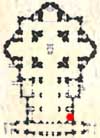| Grottoes
Vatican City Colonnade Saints Floorplan #2 |
| Altars
Monuments The History |
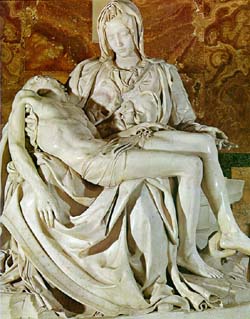
|
"MICHAEL. ANGELUS. BONAROTUS. FLORENT. FACIEBAT"
|
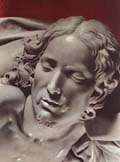
|
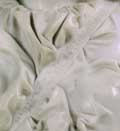 |
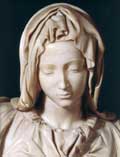 |
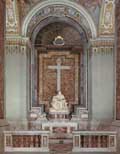 |
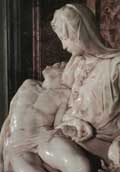 |
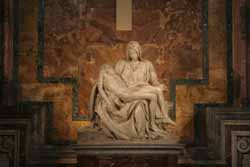 |
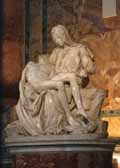 |
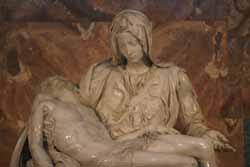 |
From:
'Guide to Saint Peter's Basilica '
This is probably the world's most famous sculpture of a religious subject.
Michelangelo carved it when he was 24 years old, and it is the only one
he ever signed. The beauty of its lines and expression leaves a lasting
impression on everyone.
With this magnificent statue Michelangelo has given us a highly spiritual and Christian view of human suffering. Artists before and after Michelangelo always depicted the Virgin with the dead Christ in her arms as grief stricken, almost on the verge of desperation. Michelangelo, on the other hand, created a highly supernatural feeling.
As she holds Jesus' lifeless body on her lap, the Virgin's face emanates sweetness, serenity and a majestic acceptance of this immense sorrow, combined with her faith in the Redeemer. It seems almost as if Jesus is about to reawaken from a tranquil sleep and that after so much suffering and thorns, the rose of resurrection is about to bloom. As we contemplate the Pieta which conveys peace and tranquility, we can feel that the great sufferings of life and its pain can be mitigated.
Here, many Christians recall the price of their redemption and pray in silence. The words may be those of the "Salve Regina" or "Sub tuum presidium" or another prayer. After Peter's Tomb, the Pieta Chapel is the most frequently visited and silent place in the entire basilica.
It is said that Michelangelo
had been criticized for having portrayed the Virgin Mary as too young
since she actually must have been around 45-50 years old when Jesus died.
He answered that he did so deliberately because the effects of time could
not mar the virginal features of this, the most blessed of women. He also
said that he was thinking of his own mother's face, he was only five when
she died: the mother's face is a symbol of eternal youth.
From:
'St. Peter's Basilica - A Virtual Tour' by Our
Sunday Visitor
Immediately adjacent is the Pietà Chapel, formerly of the Crucifix. As
in the whole of the rest of the tour, visitors should first of all look
upwards to admire the mosaic decoration of the cupola, the subject of
which centers on the Mystery of the Cross and the salvation deriving from
it. The vault shows an apocalyptic vision of the Chosen, spared by the
scourges, because they are marked on their foreheads by the angels. The
corbels show Noah's Arc, symbol of salvation, the Sacrifice of Abraham
symbolizing Jesus' sacrifice, Moses with the Tablets of the Law, and Jeremiah
imploring on the ruins of Jerusalem, which allude to the new pact of salvation.
The two lunettes closest to the altar show the Cumaean and Phrygian Sibyls,
on whose phylacteries the prophesies of the Passion are written; in the
others are Hosea, Isaiah, Amos and Zechariah, prophets of the trials and
sacrifice of Christ.
The mosaics were executed by F. Cristofari to drawings by Ferri and Pietro da Cortona. This last artist has rightly been called the Bernini of painting, due both to the number and to the artistic value of his works in the Basilica. On the small cupola above the altar is the Triumph of the Cross, frescoed by Lanfranco, the only painting in the church which has not been transformed into a mosaic.
The name of this
Chapel, which originally housed a Crucifix, changed in 1749, when Michelangelo's
Pietà was placed there. Thus both on entry and exit from the Basilica,
where the Baptistry Chapel may be found, as pointed out by Galassi Paluzzi,
there are places dedicated to Mary and to John the Baptist, that is to
Christ's mother and forerunner, who also represent the two great sources
of health: blood and water.
........................
The Pieta (Italian for “pity”), which depicts the Virgin Mary holding
the body of her son Jesus Christ after his death, has been created in
many different forms by various painters and sculpture. Of all the great
paintings and sculptures on the Pieta the one by Michelangelo stands out
from all the rest. Michelangelo was relatively unknown to the world as
an artist. He was only 24 when he was formally commissioned on Aug. 27,
1498 by Cardinal Jean Bilheres de Lagraulas, the French king’s envoy to
the pope, to do a life size sculpture of the Virgin Mary holding her son
in her arms. It would be the first of four that he would create in his
lifetime and the only one he completely finished. It was to be unveiled
in St. Peter's Basilica for the Jubilee of 1500. In less than two years
Michelangelo carved from a single slab of marble, one of the most magnificent
sculptures ever created. His interpretation of the Pieta was far different
than ones created previously by other artists. Michelangelo decided to
create a youthful, serene and celestial Virgin Mary instead of a broken
hearted and somewhat older woman.
When he received the commission for the famous sculpture, Michelangelo had been living in Rome for just two years and had only completed two sculptures, a lost Cupid-Apollo and a Baccus for the banker Jacopo Galli. When it was first unveiled in the chapel of Santa Petronilla in the old St. Peter’s, a proud Michelangelo stood by and watched as people admired the beautiful Pieta. Perhaps his pride turned into anger as he overheard a group of people attributing the work to other artists of his time. This caused Michelangelo to add one last thing to his sculpture. Across the sash on the Virgin Mary, Michelangelo carved his name. "MICHAEL. ANGELUS. BONAROTUS. FLORENT. FACIEBAT" (Michelangelo Buonarroti of Florence Created This). He later regretted that his emotions got the best of him and vowed to never sign another one of his works again. The statue stands 69 inches high and depicts a surprisingly young Mary. Asked why he chose to portray Christ’s mother like that, Michelangelo answered, “Women who are pure in soul and body never grow old.”
The cardinal had planned to use the Pietà for his tomb. Sometime in 1497 the cardinal and Michelangelo had reached an agreement about the commission and on November 18 the cardinal wrote to the officials of the tiny republic-state of Lucca, to the north of Rome in Tuscany. He requested they help Michelangelo find the marble he would need for the statue. “We have recently agreed with master Michele Angelo di Ludovico, Florentine sculptor and bearer of this, that he make for us a marble tombstone, namely a clothed Virgin Mary with a dead Christ naked in her arms, to place in a certain chapel, which we intend to found in St. Peter’s in Rome. … And on his presently repairing to those parts to excavate and transport here the marbles necessary for such a work, we confidently beg your lordships out of consideration for us to extend to him every help and favor in this matter. . . .” Lucca was known for its marble quarries, including Carrara, which yielded the largest, finest blocks of the brittle white stone that was so hard to work with, but especially prized by sculptors. From the end of November 1497 to the end of December Michelangelo was in Carrara getting the marble he needed. When the statue was installed in 1500 Cardinal Bilheres had died.
Vasari, when talking about the Pietà, says: "No sculptor or supreme artist could ever consider it possible to add with design or grace nor with effort improve the elegance, linearity and sculpt the marble with such artistic talent."
From: 'Guide to
St Peter's Basilica' © Libreria Editrice
Vaticana
The abbot commissioned the sculpture to decorate his tomb inthe ancient
Chapel of St Michael Archangel and St Petronilla, built on the external
left side of the Constantinian Basilica. Before 1520 the chapel was destroyed
to give room to the building of the new Basilica and the Pietà was moved
to the ancient secretaire, to the left side of the facade, one of the
places where the Pope doned the vestments when he celebrated in St Peter's.
In 1568, on the suggestion of the Vatican Canon Antonio Carafa, it was moved and set over the altar of the Chapel of the Choir, built by Sixtus V and dedicated to the Immaculate Conception. The new location soon showed some drawbacks: the poor light inside affected visibility and visitors were not allowed to enter the Basilica during the liturgies. The Canon Ludovico Bianchetti tried to solve those problems. For the Holy Year of 1575 he adorned the Virgin's neck with a marble ornament and put her on a base, but this made the work hidden even more.
Paul V approved the building of the new aisle in 1609 and the Pietà was moved again, awaiting to be set in the new Choir. It was temporarily located in the room prepared to officiate the canons - the left side transept, over the altar of Sts Simon and Jude (at present the altar of St Joseph). After the decision to adorn the altar of the Chapel of the Choir with a mosaic representing the Immaculate Conception, it was noted that the presence of two Madonnas was not possible.
On the night of December 3, 1749 Pope Benedict XIV ordered its further and definitive moving, together with the elliptic cottanello base, made by Francesco Borromini in 1626, then modified in 1968.
New York World's
Fair Guidebook 1964/1965
The most important work of art at the Fair is on display here. Michelangelo's
469-year-old masterpiece in carved Carrara marble, the Pietà, generally
held to be one of the finest examples of Christian art in any medium.
Installed in Old St. Peters Basilica in 1499, it had never been taken
from the Vatican until the late Pope John XXIII granted permission for
it to be brought to the Fair. The pavilion in which it is exhibited is
an oval shaped building topped by a cross, with a curving wall extending
from the entrance. The pavilion and its contents have as their theme,
The Church is Christ Living in the World.
The Masterwork The Pietà represents the body of Christ in the arms of His mother just after He was taken down from the cross. The work, six feet long by five feet nine inches high, is shown in a setting created by stage designer Jo Mielziner. Spectators are carried past it on three moving platforms at different heights. There is a walkway for those who wish to view it at their own pace.
From: Vatican
Information Service
PAUL VI HAD NO INTENTION OF SELLING MICHELANGELO'S PIETA VATICAN CITY,
FEB 1, 2002 (VIS) - This morning, Holy See Press Office Director Joaquin
Navarro-Valls made the following declaration regarding the supposed intention
expressed by Pope Paul VI to sell Michelangelo's "Pietà" and give the
proceeds to the poor: "This news has absolutely no foundation. Indeed,
it was Paul VI who, following the exposition of the 'Pietà' in the United
States, gave specific indications that Michelangelo's marble sculpture
should not leave the Vatican again without special permission from the
Holy Father, through the Secretariat of State." OP/PIETA MICHELANGELO/NAVARRO-VALLS
VIS 20020201 (100)
The Pieta was damaged on Pentecost Sunday, May 21, 1972 at 11:30am with fifteen blows from a hammer by Laszlo Toth, a Hungarian-born Australian, who cried, 'I am Jesus Christ'.
From: Newsweek,
June 5, 1972
An Assassin Strikes
....Even a scratch to the 473-year old Pietà , the only signed sculpture
by the greatest sculptor of all time, would justify such caution - but
the damage in this case was sickeningly extensive. The hammer blows cleaved
the nose from the Madonna's exquisite, sorrowful face. They gouged her
left eyelid, neck, head and veil. They broke her left arm off at the elbow,
and the fingers snapped off as the hand hit the floor.
Meticulously wielding feather dusters, Vatican officials had collected more than 50 shards of marble. A few fragments were retrieved from wax drippings from candles that surround the Pietà. Three others were returned to the Vatican by tourists who took them as souvenirs.
Italy's renowned sculptor Giacome Manzu declared that he was the only one able to restore the statue.
X-rays taken before the Pietà was shipped to the New York World's Fair in 1964 revealed that the Madonna's left hand had been broken and replaced in the eighteenth century by some anonymous sculptor.
From: The New
York Times
A Hammer For the Madonna
The mutilation of Michelangelo's "Pieta" last Sunday by a mentally
disturbed young man shocked the world as an act of mayhem against one
of the supreme masterpieces in the history of Western art. Laszlo Toth,
33, a Hungarian-born Australian, had leaped over a guard rail in St Peter's
crying, "I'm Jesus Christ!" and attacked the statue with a hammer.
The left arm of the Virgin was shattered and the nose, left eye and veil
were chipped.
A personal promise by Pope John XXIII to the late Cardinal Spellman, Archbishop of New York, led to the transfer of the Pietà to the United States for display in the Vatican Pavilion at the World's Fair.
The temporary removal of the Pietà from the Vatican was nevertheless controversial. In September, 1965, Pope Paul issued a decree banning any further loans of art works in the Vatican.
During the time the Pietà was on display at the World's Fair, a reproduction took its place in St Peter's. Today's attack was the first major damage suffered by a work of art in St Peter's since a German broke two fingers off the statue of a kneeling Pope Pius VI two years ago. The statue, by the 19th-century sculptor Canova, was quickly repaired.
